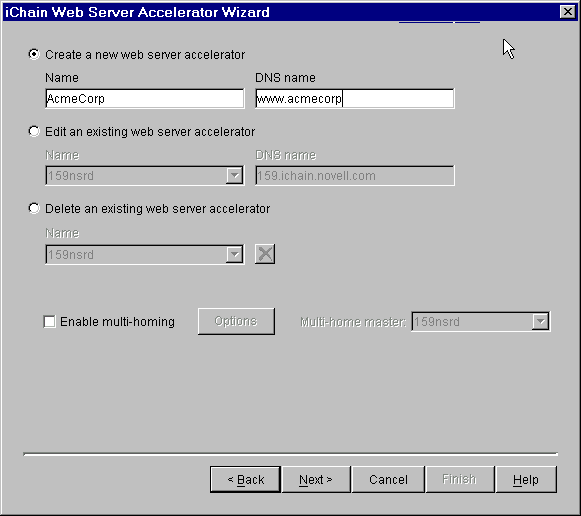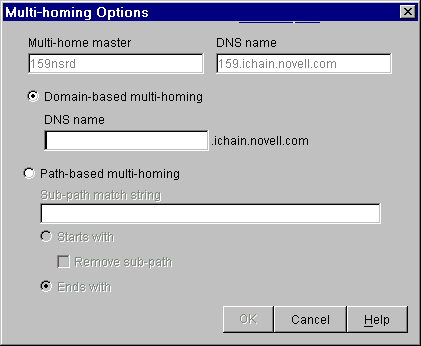The third page of the wizard is the accelerator specification page, where the user can create a new accelerator, edit an existing accelerator, or delete an existing accelerator. See Figure 45.
At this page, the user will see actual accelerator configuration data read from the proxy server if any data exists.
Create a new web server accelerator radio button |
Specifies the create operation. When selected, this option will enable the Name and DNS name fields directly under the Create section, while disabling all other fields. |
|
Name |
The name of the new accelerator, limited to 8 characters. This name must be unique. If a name is entered that is already being used, the user is prompted to choose a unique name. This name should reflect the nature of the Web server or site. That is, it should be as descriptive as possible, so as to identify what Web site is being accelerated. For example, Novell, ETN1, Compaq, etc. |
Required when creating an accelerator |
DNS name |
The DNS (Domain Naming Service) name is the name by which the Web server will be accessed. This is the name that is typically entered in a Web browser's location (URL) line. For example, the DNS name for Novell is www. novell.com. |
Required when creating an accelerator |
Edit an existing web server accelerator radio button |
Specifies the edit operation. When selected, this option will enable the Name and DNS name fields directly under the Edit section, while disabling all other fields. |
|
Name |
Lists all the existing Web server accelerators currently found on the proxy server. If the user wishes to edit an existing accelerator, he or she must select a name from the list. The corresponding DNS name will appear in the DNS name field. |
|
DNS name |
Shows the DNS (Domain Naming Service) name used by the accelerator shown in the list box to the left on the interface. This field is editable; the user can choose to edit the selected accelerator or change the DNS name. The DNS name is editable unless the selected accelerator is functioning as a path-based multi-homing child accelerator (in which case it inherits the DNS name from its master). NOTE: If you are changing the DNS name on an accelerator which has authentication enabled, the existing cookie domain may not be valid with the new DNS name if the DNS name is not a sub-domain of the cookie domain (resulting in the browser displaying a 403 Forbidden Error message). To check the cookie domain from the browser-based administration utility, select Configure > Web Server Accelerator > Modify > Authentication Options > Cookie domain. |
Required when editing an accelerator |
Delete an existing web server accelerator radio button |
Specifies the delete operation. When selected, this option will enable the Name list box to allow the user to select an accelerator to be deleted. |
|
Name |
Shows a list of all the existing Web server accelerators currently found on the proxy server. In order to delete an existing accelerator, the user must select a name from the list. NOTE: Any accelerator that is a path-based multi-homing master will not show up in the list of accelerators that can be deleted until all of its child accelerators have been deleted. |
|
Enable multi-homing for this accelerator |
If selected, this check box allows the user to set up path-based or domain-based multi-homing options for the accelerator. |
|
The Delete button allows the user to delete an accelerator. This button will only be enabled when the user selects an accelerator from the Name list box. If the user selects an accelerator from the list and clicks Delete, a warning dialog box will appear and prompt him or her to continue to delete it. If the user clicks the No button on the warning dialog box, the accelerator will not be deleted. The deletion takes place only when the user clicks Finish at the end of the wizard session.
The Options button displays the path-based multi-homing options setup dialog. This dialog box provides the necessary information to set up an accelerator to use a master for path-based multi-homing, as shown in Figure 46:
Multi-home Master |
Specifies the accelerator that will become the current accelerator's model, or master. |
Required |
Domain-based multi-homing |
When selected, multi-homes the accelerator based on a DNS name. |
Required if the Domain-based multi-homing button is selected |
DNS name |
The DNS name ends with the cookie domain of the selected multi-home Master. The user must add names to the front of the cookie domain so that this DNS name is unique for all accelerators. |
|
Path-based multi-homing |
When selected, uses the DNS name of the multi-home master. Multi-homing will be based on the sub-path match string. |
Required if the Path-based multi-homing button is selected |
Sub-path match string |
Shows the string that the system uses to route the browser request to the proper Web server. |
Required |
Starts with |
When selected, specifies that the text entered in the sub-path match string will be at the beginning of the path rule. |
Required |
Remove sub-path |
Specifies that the sub-path match string is to be removed during routing to the Web server. |
Optional |
Ends with |
When selected, specifies that the text entered in the sub-path match string will be at the end of the path rule. |
Required |







